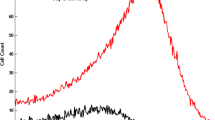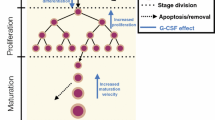Abstract
Lifespan-based pharmacodynamic (PD) models of cellular response assume that the lifespan of cells is predetermined at the time of cellular production, despite recognized changes in the cellular environment following production that may alter the survival of the cells. This work extends previously proposed cellular lifespan PD models to incorporate environmental effects on the cell lifespan by considering two basic classes of models from survival analysis: accelerated life and relative risk models. Cellular responses using both model classes were simulated using a steady-state cellular production rate with changes in the environmental effects resulting from three different basic profiles. The environmental effect models were also fitted to the red blood cell (RBC) and hemoglobin concentration data from six sheep following hematopoietic ablation by busulfan administration. The simulations indicated that the basic shapes of the cellular responses were different between the accelerated life and relative risk models. Due to the more direct physical interpretation, relatively simple steady-state relationship between the cellular response and environmental effects, and the ability to reduce the model to a “point” baseline lifespan distribution, the accelerated life model appears to be a more realistic and flexible model. The analysis of the sheep RBC and hemoglobin data indicated that the environmental effect began to decrease the survival of cells 1–2 weeks following initiation of ablation and that the average “severity” of the environmental effect increased 3.49 (29.5%) (mean (C.V.)) fold under the accelerated life model. Alternative models without an environmental effect did not describe the observed data as well. The proposed environmental effect cellular lifespan PD models allow for the incorporation of arbitrary changes in the conditions of the cellular environment and modeling of environmentally dependent cellular survival. These PD models have potential applications in hematological management of end-stage renal disease, transfusion medicine, and patients undergoing chemotherapy, among other diseases and therapies.
Similar content being viewed by others
Abbreviations
- AIC:
-
Akaike’s Information Criterion
- BV :
-
Blood volume
- e(t, z):
-
Cumulative measure of the effect of the environment
- e avg :
-
Average value of the environmental effect function
- E {·|· }:
-
Conditional mathematical expectation of a random variable
- f prod (t):
-
Production rate (i.e. input rate into the sampling compartment)
- \({f_{prod}^{SS}}\) :
-
Steady-state production rate
- g (t), h (t):
-
Environmental effect functions
- \({\ell _b \left({\tau, z}\right)}\) :
-
Baseline p.d.f. of cellular lifespans
- \({\ell _e \left({\tau, z}\right)}\) :
-
Observed p.d.f. of cellular lifespans with an environmental effect
- λ b (t, z ):
-
Baseline hazard function
- λ e (t, z):
-
Observed hazard function with an environmental effect
- μ b :
-
Mean of the baseline cellular lifespan
- μ SS :
-
Steady-state mean cellular lifespan
- MCH :
-
Mean corpuscular hemoglobin
- M :
-
Positive multiple of the baseline environmental effect function value
- v, u :
-
Arbitrary integration variables
- N (t):
-
Number of cells in the sampling compartment
- P ( · ):
-
Probability
- p.d.f.:
-
Probability density function
- PD:
-
Pharmacodynamic
- RBC:
-
Red blood cell
- σ :
-
Standard deviation of the baseline cellular lifespan
- SD:
-
Standard deviation
- S b (t, z):
-
Baseline survival function
- S e (t, z):
-
Observed survival function with an environmental effect
- SS :
-
Steady-state (super- and sub-scripted with other terms)
- τ, T :
-
Cellular lifespan, i.e. the time from input into the sampling space to the output from the sampling space (capital tau refers to a random cellular lifespan variable)
- t :
-
Time
- t 0 :
-
Time of initiation of busulfan administration
- T decline :
-
Time period over which the production rate declines from \({f_{prod}^{SS}}\) to zero
- z :
-
Time of production
References
Krzyzanski W, Ramakrishnan R, Jusko WJ (1999) Basic pharmacodynamic models for agents that alter production of natural cells. J Pharmacokinet Biopharm 27: 467–489
Krzyzanski W, Woo S, Jusko WJ (2006) Pharmacodynamic models for agents that alter production of natural cells with various distributions of lifespans. J Pharmacokinet Pharmacodyn 33: 125–166 doi:10.1007/s10928-006-9007-3
Freise KJ, Widness JA, Schmidt RL, Veng-Pedersen P (2007) Pharmacodynamic analysis of time-variant cellular disposition: reticulocyte disposition changes in phlebotomized sheep. J Pharmacokinet Pharmacodyn 34: 519–547 doi:10.1007/s10928-007-9056-2
Freise KJ, Widness JA, Schmidt RL, Veng-Pedersen P (2008) Modeling time variant distributions of cellular lifespans: increases in circulating reticulocyte lifespans following double phlebotomies in sheep. J Pharmacokinet Pharmacodyn 35: 285–323
Uehlinger DE, Gotch FA, Sheiner LB (1992) A pharmacodynamic model of erythropoietin therapy for uremic anemia. Clin Pharmacol Ther 51: 76–89
Harker LA, Roskos LK, Marzec UM, Carter RA, Cherry JK, Sundell B, Cheung EN, Terry D, Sheridan W (2000) Effects of megakaryocyte growth and development factor on platelet production, platelet life span, and platelet function in healthy human volunteers. Blood 95: 2514–2522
Krzyzanski W, Perez-Ruixo JJ, Vermeulen A (2008) Basic pharmacodynamic models for agents that alter the lifespan distribution of natural cells. J Pharmacokinet Pharmacodyn 35: 349–377 doi:10.1007/s10928-008-9092-6
Perez-Ruixo JJ, Krzyzanski W, Hing J (2008) Pharmacodynamic analysis of recombinant human erythropoietin effect on reticulocyte production rate and age distribution in healthy subjects. Clin Pharmacokinet 47: 399–415
Kruse A, Uehlinger DE, Gotch F, Kotanko P, Levin NW (2008) Red blood cell lifespan, erythropoiesis and hemoglobin control. Contrib Nephrol 161: 247–254 doi:10.1159/000130698
Cimen MY (2008) Free radical metabolism in human erythrocytes. Clin Chim Acta 390: 1–11 doi:10.1016/j.cca.2007.12.025
Durken M, Agbenu J, Finckh B, Hubner C, Pichlmeier U, Zeller W, Winkler K, Zander A, Kohlschutter A (1995) Deteriorating free radical-trapping capacity and antioxidant status in plasma during bone marrow transplantation. Bone Marrow Transplant 15: 757–762
Westhuyzen J, Saltissi D, Stanbury V (2003) Oxidative stress and erythrocyte integrity in end-stage renal failure patients hemodialysed using a vitamin E-modified membrane. Ann Clin Lab Sci 33: 3–10
Serebruany VL, Malinin AI, Pokov AN, Hanley DF (2008) Antiplatelet profiles of the fixed-dose combination of extended-release dipyridamole and low-dose aspirin compared with clopidogrel with or without aspirin in patients with type 2 diabetes and a history of transient ischemic attack: a randomized, single-blind, 30-day trial. Clin Ther 30: 249–259 doi:10.1016/j.clinthera.2008.02.006
Khosravi Shahi P, Fernandez Pineda I (2008) Tumoral angiogenesis: review of the literature. Cancer Invest 26: 104–108 doi:10.1080/07357900701662509
Novotny VM (2007) Red cell transfusion in medicine: future challenges. Transfus Clin Biol 14: 538–541 doi:10.1016/j.tracli.2008.01.001
James I (2008) Accelerated failure-time models. In: Armitageand P, Colton T(eds) Encyclopedia of biostatistics, vol. Online electronic resource. Wiley, Hoboken
Kalbfeisch JD, Prentice RL (2002) The statistical analysis of failure time data. 2nd edn. Wiley, Hoboken
Lee ET, Wang JW (2003) Statistical methods for survival data analysis. Wiley, Hoboken
Hoffman R, Benz EJ Jr, Shattil SJ, Furie B, Cohen HJ, Silberstein LE, McGlave P (2005) Hematology: basic principles and applications. 4th edn. Elsevier Inc, United States of America
Krzyzanski W, Perez-Ruixo JJ (2007) An assessment of recombinant human erythropoietin effect on reticulocyte production rate and lifespan distribution in healthy subjects. Pharm Res 24: 758–772 doi:10.1007/s11095-006-9195-y
Landaw SA (1988) Factors that accelerate or retard red blood cell senescence. Blood Cells 14: 47–67
Chapel S, Veng-Pedersen P, Hohl RJ, Schmidt RL, McGuire EM, Widness JA (2001) Changes in erythropoietin pharmacokinetics following busulfan-induced bone marrow ablation in sheep: evidence for bone marrow as a major erythropoietin elimination pathway. J Pharmacol Exp Ther 298: 820–824
Mock DM, Lankford GL, Burmeister LF, Strauss RG (1997) Circulating red cell volume and red cell survival can be accurately determined in sheep using the [14C]cyanate label. Pediatr Res 41: 916–921 doi:10.1203/00006450-199706000-00020
Neelakantan S, Widness JA, Schmidt RL, Veng-Pedersen P (2006) A "bottom-up" approach for endo-PK/PD analysis. Biopharm Drug Dispos 27: 313–327 doi:10.1002/bdd.508
Wade L Jr, Sasser LB (1970) Body water, plasma volume, and erythrocyte volume in sheep. Am J Vet Res 31: 1375–1378
Veng-Pedersen P (1977) Curve fitting and modelling in pharmacokinetics and some practical experiences with NONLIN and a new program FUNFIT. J Pharmacokinet Biopharm 5: 513–531 doi:10.1007/BF01061732
Piessens R, deDoncker-Kapenga E, Uberhuber CW, Kahaner DK (1983) QUADPACK. Springer, New York
Akaike H (1974) Automatic control: a new look at the statistical model identification. IEEE Trans 19: 716–723
Tucker EM (1963) Red cell life span in young and adult sheep. Res Vet Sci 4: 11–23
Belair J, Mackey MC, Mahaffy JM (1995) Age-structured and two-delay models for erythropoiesis. Math Biosci 128: 317–346 doi:10.1016/0025-5564(94)00078-E
Woo S, Krzyzanski W, Jusko WJ (2008) Pharmacodynamic model for chemotherapy-induced anemia in rats. Cancer Chemother Pharmacol 62: 123–133
Cetin T, Arpaci F, Yilmaz MI, Saglam K, Ozturk B, Komurcu S, Gunay M, Ozet A, Akay C, Kilic S, Ulutin C (2004) Oxidative stress in patients undergoing high-dose chemotherapy plus peripheral blood stem cell transplantation. Biol Trace Elem Res 97: 237–247 doi:10.1385/BTER:97:3:237
Sangeetha P, Das UN, Koratkar R, Suryaprabha P (1990) Increase in free radical generation and lipid peroxidation following chemotherapy in patients with cancer. Free Radic Biol Med 8: 15–19 doi:10.1016/0891-5849(90)90139-A
de Franceschi L, Turrini F, Honczarenko M, Ayi K, Rivera A, Fleming MD, Law T, Mannu F, Kuypers FA, Bast A, van der Vijgh WJ, Brugnara C (2004) In vivo reduction of erythrocyte oxidant stress in a murine model of beta-thalassemia. Haematologica 89: 1287–1298
Arnold BC, Reneau DM, Samaniego FJ (1989) New moment-identities based on the integrated survival function. IEEE Trans Reliab 38: 358–361
Author information
Authors and Affiliations
Corresponding author
Rights and permissions
About this article
Cite this article
Freise, K.J., Schmidt, R.L., Widness, J.A. et al. Pharmacodynamic modeling of the effect of changes in the environment on cellular lifespan and cellular response. J Pharmacokinet Pharmacodyn 35, 527–552 (2008). https://doi.org/10.1007/s10928-008-9100-x
Received:
Accepted:
Published:
Issue Date:
DOI: https://doi.org/10.1007/s10928-008-9100-x




